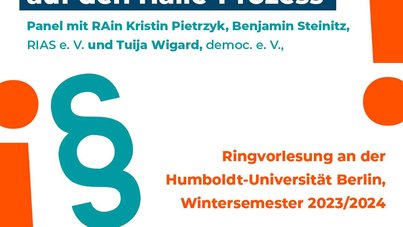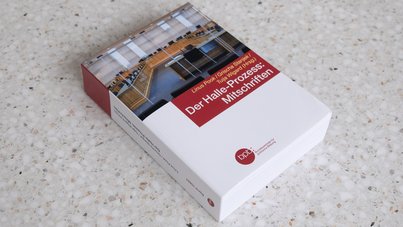Halle-Trial: Closing Statement of a Survivor from the Synagogue
“The idea of ‘Never again’ has already been disproven.”
Note: The original German version was read during the trial proceedings on December 1st, 2020. The following English version has been amended in order to clarify and give further background to German memorial culture and history.
There have been two attacks on the two synagogues of the Jewish community. Each occurred on the 9th day of an autumn month.
The first was in November 1938, during the November Pogrom [often called Kristallnacht in English].
The second was in October 2019, on the Jewish holiday of Yom Kippur.
We are here today because of both of them.
There is a physical, historical connection linking the attacks. The present-day synagogue, that is the second synagogue, stands only because the first was destroyed on November 9th, 1938. This is already evident in the current synagogue’s layout, as a cemetery lies between the synagogue building and the street. Synagogues are not typically built next to cemeteries.
There is also an ideological connection linking the attacks – anti-Semitism. Above all, anti-Semitism impacts Jews. One of the main principles of anti-Semitism is to mark Jews as foreign. Sometimes this idea of “foreignness” is extended to other groups. This is what happened in the Halle attack, when, after the onslaught of the synagogue, others were attacked due to their perceived “otherness”-including those in the Kiezdöner.
The perpetrator very much referenced this historical and ideological continuity when, at the beginning of his live-stream, he denied the Holocaust and professed anti-Semitism.
While I was in the synagogue, and tried to protect myself and hide somewhere, I could not have known what the perpetrator said. I did not see the live-stream. Neither did I need too in order to understand that there are still people who would gladly live in a homogenous society, according to their specific standards. This idea shaped Europe in the 20th century and was the reason why my ancestors needed to flee to the United States. For that I can only be thankful, as it’s much of the reason why I’m alive today.
The expression “L’Dor V’Dor” is one that those ancestors transmitted. It’s an influential idea from Judaism that means “from generation to generation” in Hebrew. As a kid, I never imagined that at some point I would fear, as a Jew, for my life. Such a thing belonged to the past, I thought. What I did not understand was that the past remains a part of our present.
“L’Dor V’Dor” is often used in an educational sense. The older generation teaches the younger one. We are obligated to learn about the past so that we can make the present, and thereby the future, better.
As I learned more about the concept of Erinnerungskultur, I couldn’t help but compare it with the more familiar idea of “L’Dor V’Dor.” One translation of Erinnerungskultur is Memorial Culture. Though it has roots in the 1950s in both East and West Germany, Erinnerungskultur as known today began in the 60s and 70s, after the trial of Adolf Eichmann. Although Erinnerungskultur and “L’Dor V’Dor” are ideas that stem from two distinct perspectives and time periods, both are attempts to answer the question: how should a group engage with the events of the past?
One might say that Memorial Sites and Museums at former Concentration Camps are one concrete answer to this question, from the perspective of Erinnerungskultur.
As an exchange student in high school and then in the past year while completing a volunteer service year at a Memorial Site, I learned extensively about this German memorial culture. At work, two sentences that I heard almost daily were “Never again” [Nie wieder] and “Never forget” [Nie vergessen].
“Never again” – Never again should Germany become a dictatorship. Never again should genocide happen. Never again should people who do not belong to the “national community” [i.e. the “Volksgemeinschaft”], be imprisoned and interned in prisons and concentration camps. And, above all, never again should Jews, and other minorities, fear for their lives.
The idea of “Never again” has already been disproven.
While attending the German Parliament’s Memorial Hour on the Day of Remembrance of the Victims of National Socialism, German President Dr. Frank-Walter Steinmeier said something noteworthy in his speech:
“My worry is that we [Germans] understand the past better than the present. We thought that the older ghosts would pass with time. But no: The evil ghosts of the past are revealing themselves today in a different guise.”
Two attacks belong now to the past. Though 75 years separate them, they are connected through an ideology of hate.
After the attack I had many questions. In the time since the attack several of them have been answered, though I still have many. One of those remaining is: how many people must die and how many people must fear for their lives, until the societal majority understands that hatred of minorities has never gone away??
There was even discrimination and violence against Jews shortly after the end of the Second World War! Yet at the same time, there were many Jews who just wanted to live and celebrate and try to enjoy the world after having been ripped from it.
In Judaism, the past, and remembrance of it, is important. Many Jewish holidays explain what happened long ago. Why? Because Zichronot, Hebrew for memories, remain with us. We must remember what happened, whether good or bad, and transmit it to future generations.
Though they both reference remembering, there is a great difference between the understanding of Erinnerungskultur [German memorial culture] and Zichronot. This difference is not only one of thousands of years; rather, it’s one of time orientation. German Memorial Culture tries to remember and to memorialize the past in the present. Zichronot, however, is dually concerned with the past and future. This is why every year on Yom HaShoah, Holocaust Remembrance Day, we say “Yizkor.”
Yizkor: it means, “one will remember.” The word is etymologically tied to Zichronot. Yet Yizkor is grammatically a word that belongs to the future and not the past, since it is in the future tense. It is a promise to remember that must be renewed each year. It is a wake-up call that rings regularly, so that we do not get too comfortable and begin to forget.
The idea is perhaps paradoxical as it divides time by dividing it into what was, what is, and what will be while uniting them in the present. That is exactly why it works. Remembrance works when one allows the cacophonous cries of the past, the present, and the future to be heard at once. No time period can exist without the influence of others.
I am young and have my entire life in front of me. I cannot forget what happened during the attack. It will forever be something that impacts my present and my future in various ways, even though it is something that occurred in my past. As long as I am alive, I will continue to write about what I lived through then and what continues to affect me. As part of that, I will give voice to those 6 million victims of the Shoah who cannot speak for themselves as well as those who survived violence after the war yet were not taken seriously by authorities. I am able to do this because I survived. I only hope that people will listen.
I would like to recall the words of an earlier survivor by the name of Ellie Wiesel. After surviving Auschwitz and Buchenwald, he wrote a book now known as Night. His first draft of the book, written in Yiddish, gave it a different title “Un di velt hot geshvign,” meaning “And the World Remained Silent.”
The silence against anti-Semitism and against white supremacy must be broken. You all, as members of the dominant culture, must play a part.
Two attacks are already two too many. Let it not be more.


